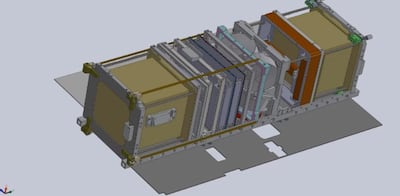University students in the UAE are building a miniature satellite to measure charged particles above thunderstorms that release harmful levels of radiation and can endanger aircraft passengers.
The particles – known as terrestrial gamma-ray flashes (TGF) – with one flash can expose plane passengers to the equivalent of 400 chest X-rays.
The flashes can also play havoc with a plane's electronics, putting passengers and crew at risk.
Students at NYUAD and Khalifa University are building the satellite – Light-1 CubeSat – which will have a special crystal detector to measure the flashes.
Flashes hit the crystals and it helps the team to measure their potency.
"These are really powerful events," said Ahlam Al Qasim, a physics graduate from NYUAD, during a recent online seminar about the project. The project involves current students and those who have graduated.
“To give you an idea of how powerful they are – a lightning strike ... produces voltages of about 500 kilovolts, which is strong enough to kill a person if it strikes them.
“TGFs can reach energy of up to 100 mega electron volts – implying they give off more than 100 megavolts. That’s very high energy.”
The phenomenon was accidentally discovered by space scientists at US space agency Nasa in 1992 when carrying out studies about cosmic gamma-ray flashes, which occur outside Earth's atmosphere.
TGFs are created above thunder clouds, last only a few milliseconds and escape into the atmosphere.
"Aircraft fly on top of clouds all the time and if they were to fly within the vicinity of where one TGF would be emitted, it's actually very dangerous for people on board and also for the [aircraft] electronics," Ms Al Qasim said.
“So we need to understand these things better to help us really avoid the danger that might come with it.”
Because TGFs are a relatively new discovery, there are not many conclusions made about them, including how many occur daily.
Nasa estimated about 1,100 happen every day but the number could be higher because low-altitude ones are possibly being missed.
Current data shows that TGFs strike about 11 to 14 kilometres above thunderstorms.
The Light-1 CubeSat could help fill in the gaps and will measure how and where the flashes are triggered and why.
An advanced photo sensor will be installed on the satellite to help carry out its objective.
A launch date and service provider is yet to be announced but details are expected soon.
“Our photo sensor is currently the fastest gamma-ray detector for TGF science and it’s really small,” said Aisha Al Mannaei, another NYUAD graduate who is working on the satellite.
“However, it is also scalable, which means that if we get multiple components of the photo sensor, plus the ... crystal, we can actually make this detector really big for larger missions.”
“These crystals are specialised and excited in a very unique way to calculate those gamma-rays that we receive.”
Nasa’s Fermi Gamma-ray space telescope has been studying the flashes since its launch in 2008.
It has recorded more than 4,000 so far with a mission to help scientists understand how the phenomenon affects lightning activity and the life cycle of storms.
Scientists have learnt that weaker storms can produce a greater number of TGFs because they can arise anywhere in the storm.
In hurricanes and typhoons, TGFS are more common in areas that have the highest lightning rates.



